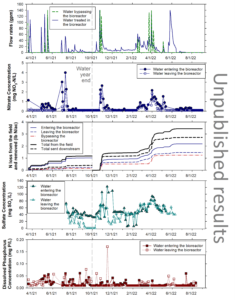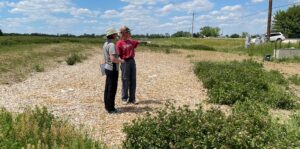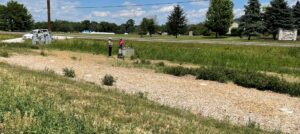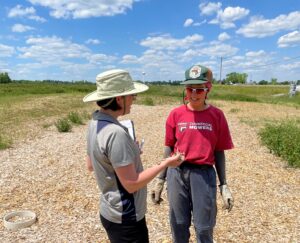Final report for FNC21-1279
Project Information
My farm, located near Peoria, Illinois, is 176 acres total with 60 tillable acres. Eight acres are planted in prairie strips under the Conservation Reserve Program, and the remaining tillable acres were in cover crops in 2020 and 2021 for the organic transition followed by organic corn in 2022. The fields were certified organic in 2022. New tiles were installed on about 30 acres in early 2020 to improve drainage for better productivity. Along with that land improvement, I worked with the Natural Resources Conservation Service (NRCS) to design/build a woodchip bioreactor which was installed in November 2020.
Improved drainage via tiling is essential for economically viable crop production in many parts of the North Central Region but this practice contributes to water quality problems by increasing nitrogen (N) loss from fields. A woodchip bioreactor is a trench full of woodchips that cleans N from tile drainage water using the natural process of denitrification. This study monitored a bioreactor at my Illinois farm during transition to organic production. Importantly, this was the first study of a bioreactor with an organic cropping system. Summed over the two-year monitoring period, the bioreactor was 47% efficient at removing N from the water that flowed through it, and 33% efficient considering untreated water that was routed around the bioreactor. This compares favorably to the 25% edge-of-field efficiency that bioreactors are rated at in Illinois. Bioreactors promote stewardship of our water resources (ecologically sound), are a cost-effective practice for reducing N loss in tile drainage water (economically viable) and are socially responsible in that they provide cleaner water for downstream neighbors and ultimately the Gulf of Mexico.
- Perform the first-ever assessment of a woodchip bioreactor treating tile drainage from an organic cropping system.
- Measure tile drainage nitrogen concentrations and loads during early transition from conventional to organic cropping methods and compare to research data from conventional cropping systems.
- Share information about bioreactors in general and new findings about organic cropping nitrogen loads via popular press articles and newsletters.
- Raise awareness in the agricultural community of the importance of farmers taking responsibility for the quality of water drainage from their farms.
Cooperators
- (Educator and Researcher)
Research
My woodchip bioreactor was designed by the USDA NRCS and installed in November 2020 at my Peoria County, Illinois farm. It is 54 ft long x 16 ft wide x 4.9 ft deep. Design details can be found in the construction package from the NRCS: Johnson Bioreactor Construction Docs
My bioreactor treats drainage from 20 acres that were planted in clover and oats in spring 2020. Cover crop of oats and radishes were broadcast in fall 2021. Organic corn was planted in spring 2022. Cover crop of cereal rye was planted in fall 2022.
An automated water sampler (Teledyne ISCO Model 3700, Lincoln, NE) and water sensor (HOBO U20L-04 Water Level Logger, Onset Corp., Bourne, MA) were deployed in March 2021 at both the bioreactor inflow and outflow control structures. The autosamplers collected samples every four days from the inflow and outflow and those samples were brought monthly to the University of Illinois Christianson lab for nitrate-nitrogen analysis (Lachat Quickchem, method 10-107-04-1-A, Loveland, CO). The flow in both the inflow and outflow control structures was logged by the water sensors and was used to calculate nitrate-nitrogen mass loads (in lb N/ac) by being paired with the water sample concentrations. Dissolved phosphorus and sulfate were added-value parameters, which were not originally proposed, that were also studied (Lachat Quickchem, method: 10-115-01-1-A; Hach DR3900 Spectrophotometer, method 8051, Loveland, CO).
Results table
|
Start date |
End date |
% of water from the field treated |
lb N/ac from field |
lb N/ac into bioreactor |
lb N/ac removed by the bioreactor |
Bioreactor removed (%) |
Edge-of-field removed (%) |
|
3/19/2021 |
9/30/2021 |
84 |
1.2 |
1.0 |
0.8 |
77 |
66 |
|
10/1/2021 |
9/1/2022 |
79 |
3.4 |
2.2 |
0.7 |
33 |
21 |
|
|
|
TOTAL SUM |
4.6 |
3.2 |
1.5 |
47 |
33 |
Results graph
- Past research has shown that diverse crop rotation with cover crops reduces N loss from tile drainage.1,2 My non-conventional crop rotation with cover crops (i.e., not corn + soybeans) is likely responsible for the very low drainage nitrate concentration and low drainage flow from my fields. This resulted in low nitrate loss of ~1 to 4 lb N/ac annually compared to median nitrate loss of 20.5 lb N/ac for tile-drained fields in the western Midwest (IA, IL, MN).3
- Because my nitrate loss was so low, my bioreactor performed better at 33% (summed over two years) compared to the 25% edge-of-field efficiency that bioreactors are rated at in Illinois.4 Of course, this 33% removal was a very small mass value.
- The bioreactor removed 13% of the dissolved phosphorus that was routed into it in the first year and leached phosphorus from the woodchips in the second year, though phosphorus amounts were very low.
- Sulfate naturally present in the drainage water was being removed by the bioreactor during the low flow summer months.
_______________
1Diverse Crop Rotation Reduces Nitrate Loss Through Tile Drainage on Illinois Farm, Illinois Sustainable Ag Partnership, October 11, 2022, https://ilsustainableag.org/diverse-crop-rotation-reduces-nitrate-loss-through-tile-drainage-on-illinois-farm/
2Dissolving uncertainty: A comprehensive evaluation of tile drainage nutrient concentrations, Illinois Drainage Research and Outreach Program (I-DROP), http://draindrop.cropsci.illinois.edu/index.php/i-drop-research/archived-projects/dissolving-uncertainty-a-comprehensive-evaluation-of-dissolved-p-in-tile-drainage
3Christianson, L.E. and R.D. Harmel. 2015. 4R Water Quality Impacts: An Assessment and Synthesis of Forty Years of Drainage Nitrogen Losses, Journal of Environmental Quality. https://doi.org/10.2134/jeq2015.03.0170
4Illinois Nutrient Loss Reduction Strategy. https://www2.illinois.gov/epa/Documents/iepa/water-quality/watershed-management/nlrs/nlrs-final-revised-083115.pdf
Educational & Outreach Activities
2. Brunton, Ann. 2022. Master of Science Thesis.
Participation Summary:
- My bioreactor is identified as a demonstration site on the Conservation Story Map of the Illinois Sustainable Agriculture Partnership. The public is invited to tour my bioreactor by appointment. https://ilsustainableag.org/learn/conservation-story-map/?maplayers%5B%5D=Topographic#mapleton-bioreactor-demo-site
- An outreach article titled “Woodchip Bioreactors: Installation Process and Chemistry Inside” by Dr. Shirley Johnson with Dr. Laura Christianson was published in the Illinois Land Improvement Contractor’s Association bi-monthly newsletter, March/April 2022, pp. 12-14. https://www.illica.net/_files/ugd/f15a8b_48c8e480875e451b803711581242df05.pdf. Drainage contractors are a key stakeholder group for this type of water quality practice in Illinois.
- Dr. Laura Christianson and I were featured in an episode of “Science Friday,” a nationally broadcast public radio series (approximately 1.8 million listeners), to discuss bioreactors. Citation:
- Science Friday (Feather, Katie). 07 May 2021. Can woodchips help the Gulf of Mexico’s Dead Zone? https://www.sciencefriday.com/segments/woodchips-fertilizer-runoff/
- This research at my bioreactor is being leveraged with several other research projects. Scientific presentations (which included data collected as a part of this SARE grant) were made at national scientific meetings:
- Díaz-García, C., L. Christianson, R. Christianson, and R. Cooke. 2022. The Internet of Bioreactors: Real-time nitrate sensors at denitrifying bioreactors. 11th International Drainage Symposium. Des Moines, Iowa. 30 Aug – 02 Sept 2022.
- Brunton, A., J. Zilles, R.A. Cooke, and L. Christianson. 2021. Nitrous oxide emissions from denitrifying bioreactors with and without a soil cover. 2021 ASA-CSSA-SSSA International Annual Meeting. Salt Lake City, Utah. 07-10 November 2021. https://scisoc.confex.com/scisoc/2021am/meetingapp.cgi/Paper/138489
- Maxwell, B., R. Arch, R. Christianson, S. Johnson, and L. Christianson. 2021. Cost efficiency analysis and nitrate removal performance of six Illinois woodchip bioreactors. 2021 ASA-CSSA-SSSA International Annual Meeting. Salt Lake City, Utah. 07-10 November 2021. https://scisoc.confex.com/scisoc/2021am/meetingapp.cgi/Paper/138432
- Publications:
- Christianson, L.E., R.D. Christianson, C. Díaz-García, G.M. Johnson, B.M. Maxwell, R.A.C. Cooke, N. Wickramarathne, and L. Gentry. Under review 2022. Denitrifying bioreactor in situ woodchip bulk density. Submitted to special collection in the Journal of the ASABE.
- Alves de Oliveira, L., H. Dougherty, R.A. Cooke, B. Maxwell, M. Helmers, F. Birgand, C.M. Pittelkow, R.D. Christianson, and L.E. Christianson. Under review 2022. Aspect ratio and horizontal baffles impact hydraulic performance of full-size denitrifying bioreactors. Submitted to Ecological Engineering.
- Brunton, Ann. 2022. Nitrous oxide and methane emissions from denitrifying bioreactors with and without a soil cover. MS thesis. Agricultural and Biological Engineering, University of Illinois. Urbana, Illinois.
- Christianson, L.E., N. Wickramarathne, G.M. Johnson, and G.W. Feyereisen. 2022. No/low-cost chipped woody debris nutrient composition benefits and tradeoffs for denitrifying bioreactors. Bioresource Technology Reports 20: 101237. https://doi.org/10.1016/j.biteb.2022.101237
The attached photos show Dr. Laura Christianson and me at the bioreactor. The gray box contains the autosamplers made possible by this SARE grant.
Learning Outcomes
- My bioreactor is performing as intended, removing nitrate from tile water exiting the farm. The bioreactor was a good addition to my farm to help protect downstream water quality.
- It’s curious that N loss from my fields was so low compared to other tile-drained fields. Low N loss from my fields is likely due to diversified crop rotation including cover crops, though there may be other contributing factors.
- A byproduct of bioreactor operation can be hydrogen sulfide gas. I rarely smelled hydrogen sulfide (rotten eggs) at my bioreactor, but noticed it when flow through the bioreactor was very low. Adjusting flow rate to keep water moving through the bioreactor helps minimize hydrogen sulfide emission.
Project Outcomes
I purposefully sited the bioreactor near the road so people would see it. When I’m working near the bioreactor, it’s not uncommon for someone to pull over and ask me what’s going on. An NRCS technician told me that several people pulled over to ask him about the bioreactor when he was inspecting it. People ask what the boxes are that contain the automatic water samplers (made possible by this SARE grant). It’s been great to have the opportunity to talk with random folks about the benefits of a bioreactor. With so much interest, NRCS installed signs that read “Natural Resources Conservation Service Partner” near the bioreactor.
- It would be interesting to compare N loss from organic and conventional farms, both with diversified crop rotation, to evaluate how farm practice (organic versus chemical) affects N loss.
- I would encourage more funding for edge-of-field practices, because water quality is such a critically important area.
- I would suggest to offer farmers who have received a SARE grant the option to re-apply to continue their projects beyond two years, if additional study is warranted. Perhaps also consider longer-term grants at the onset. On-farm empirical studies may benefit from longer timeframes to account for variation due to uncontrollable factors such as weather.



